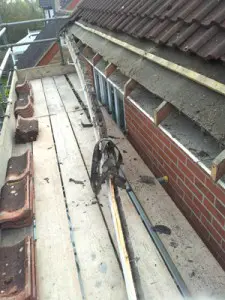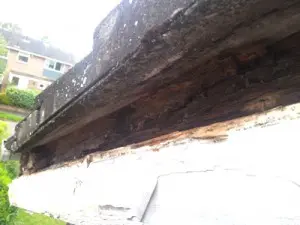How To Repair Rotted Rafter Tails
 Roofline Replacement Step 2 – Preparing Rafter Feet
Roofline Replacement Step 2 – Preparing Rafter Feet
The rafter feet are a central part of your roofline structure. They must exist solid then you lot can fit your replacement roofline components.
In my previous post, Roofline Ripping Out, I described how to remove the visible components of your existing roofline. The side by side stage is to check and prepare the rafter anxiety. There are 2 parts to this stage – 'preparing the rafter anxiety' and 'splicing'. Both are equally important.
Rafter feet are generally spaced just under a meter apart, along the length of the run. Afterwards you've done a few elementary checks you may find y'all need to carry out carpentry piece of work to restore your rafter feet.
Important: Exercise not effort to fit your replacement fascias to rafter anxiety that take any indication of rot. If you do, your roofline is likely to develop issues sooner rather than lasting for many, many years every bit it should.
Recollect, structural wood, such as rafter feet, needs to exist replaced if you spot whatsoever weaknesses. Do not attempt to tidy up with filler. Filler material is purely cosmetic, it has no strength for supporting any weight.
Rafter Feet Checks

As you check each of the rafter anxiety await for obvious signs of weakened wood.
Has the wood colour inverse because of damp?
Are there any tiny holes? These are telltale signs of woodworm. In fact woodworm tin sometimes be more of a problem than wet rot.
If you suspect woodworm or wet rot in your rafter feet y'all must cut dorsum the affected expanse completely and splice a new piece alongside.
If y'all are unlucky plenty to have an extreme example, where the rot has spread farther than the eaves, then you must notice a more than solid fixing further upward the roof. You may have to become into the attic space. If this is the case then information technology is about likely that the tile battens (these are the strips of forest that your roofing tiles are held on) are resting on the rotted rafters.
Information technology is a very catchy job to carry out and I urge y'all to get a competent installer to sort it out for you. If you attempt to practise information technology yourself and remove wood that tile battens balance upon you could collapse sections of your roof and greatly harm the roofing felt. And then, my professional advice is, do not attempt to remove wood past the first batten.
OK, having checked for visible signs of problems, you need to be sure the wood is every bit solid every bit information technology looks.
Use a apartment headed screwdriver to stab into the grain of the wood of each of the rafter anxiety. If the woods crumbles or flakes and then it needs to be replaced.
Professional Tip: Always conduct out checks and repair or replace your rafter feet earlier you measure for the replacement fascias – if you lot measure earlier you do any rafter feet splicing that is needed you lot may become fitting problems.
Do Your Rafter Feet Actually Need Attending?
All rafter feet accept a piffling rot or discoloration from where the old nails have rusted and left stains and larger holes than the size of the nails that came out. This is normal and they practice not need any remedial work.
Professional person Tip: If the tests you carried out with the screwdriver did not highlight whatever rotting woods, then the best way to brand doubly sure your rafter foot is strong plenty is to examination a fixing:
Drive a woods blast in with a hammer and give it a jerk. A good solid fixing hardly moves whereas a bad ane does non hold the 'bite' of the nail.
Rafter Feet – Splicing
If you've established your rafter foot does have some rot you demand to prepare it ready to splice a new, strong piece of wood onto it:
Using a sharp woods saw, cut past any rot with a dainty clean, angled cut and remove the decayed timber.
Always be careful when removing wood on gable ends as it is very easy to accidentally lose the verge cement. If yous accept any concerns that this may happen then it is best to leave it and seek professional assistance. Verge cement can drop, along with tiles, giving yous a serious roof plummet.

It is as well very common for gable ends to have their trusses (sometimes chosen gable ladders) resting and stock-still on purlins. These support the entire roof and prevent sagging.
Purlins are made of woods that is much harder than the wood used for trusses. All the same, they can rot but as easily and can cause very severe structural bug when they do. A totally rotted purlin is useless and cannot exist cut dorsum past the wall.
If your purlin is rotted do non attempt to replace information technology, seek professional aid. Unfortunately a rotted purlin may exist an indication that you need a new roof.
Always make sure the new wood yous are going to use for splicing is the same thickness as the existing timber – i.e. 3"x2" volition need 3"x2", iv"x2" will need iv"x2". I know this sounds trivial and absolutely obvious but I ofttimes come across pocket-size DIY jobs that have used whatever wood was lying about in the shed.
Using these scraps of incorrectly sized timber is false economy – the splice may appear solid when first done merely is unlikely to last more a year or two. I urge you to make a wise investment – buy the correct size wood.
When splicing the new wood onto the existing rafter feet, you want to become a proficient bite into the two pieces of wood, so employ loftier quality wood screws of around 70mm to 90mm – these give you a firm fixing.
Use a power drill to pilot pigsty each fixing with a slightly slimmer drill bit than the thread of the spiral – this helps to avoid splitting the wood whilst providing a good bite.
Brand at to the lowest degree two fixings and then in that location is no movement afterwards. If you use but one spiral yous create a 'come across-saw' upshot where the forest moves under pressure.
Splicing alongside rafter feet is generally done on a fascia soffit gutter run. Replacing the rotten surface area only is likewise short for a firm hold. You are basically trying to mimic the rafter feet either side of the affected timber. Information technology is not essential for it to be exactly uniform with the rest at this stage.

Splicing in a gable ladder is slightly harder. Over again, an angled cut by the rot on the wood will help you to get a good set up merely it may take several trips upwardly the ladder to achieve a neat and tidy measurement.
Getting the angles right is key here and then it is very helpful if the original rotted wood comes off in ane slice so y'all can employ it equally a template.
Once the new wood is cut and tested for a tight fit, drive in the screws after piloting and make sure that it is firm and stays in position when you effort to wiggle it.
This is the 2nd of the 9 steps our professional fitters carry out when fitting a replacement roofline. Equally you tin can come across, yous must take dandy care to avoid damaging your roof unintentionally.
This is why many householders decide to get it done by professionals.
My fitters at Anglia Roofline are specialists at installing replacement rooflines – this is the merely blazon of edifice work we carry out.
Related Posts:
Roofline Ripping Out
Replacing Your Roofline
Roofline Repair Tools
Roofline Nest
Source: https://www.angliaroofline.co.uk/rafter-feet/

0 Response to "How To Repair Rotted Rafter Tails"
Post a Comment